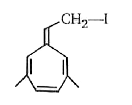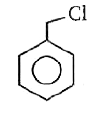Write the structure of an isomer of compound which is most reactive towards reaction.
To find the structure of an isomer of the compound C4H9Br that is most reactive towards SN1 reactions, we will follow these steps:
Step 1: Identify the possible isomers of C4H9Br
The molecular formula C4H9Br indicates that we have a brominated alkane with four carbon atoms. The possible structural isomers of butane (C4H10) can be:
1. Butyl bromide (1-bromobutane):
- Structure: CH3−CH2−CH2−CH2Br
2. Isobutyl bromide (2-bromobutane):
- Structure: CH3−CH(CH3)−CH2Br
3. Sec-butyl bromide (2-bromobutane):
- Structure: CH3−CH2−CHBr−CH3
4. Tert-butyl bromide (2-bromobutane):
- Structure: (CH3)3CBr
Step 2: Analyze the reactivity towards SN1 mechanism
The SN1 mechanism involves the formation of a carbocation intermediate. The stability of the carbocation is crucial for the reactivity of the compound. The order of stability for carbocations is:
- Tertiary (3°) > Secondary (2°) > Primary (1°)
Among the isomers listed, the one that can form a tertiary carbocation is tert-butyl bromide:
- When tert-butyl bromide undergoes SN1 reaction, it forms a tertiary carbocation:
(CH3)3C+
This tertiary carbocation is highly stable due to hyperconjugation and inductive effects from the surrounding alkyl groups.
Step 3: Write the structure of the most reactive isomer
The structure of the isomer of C4H9Br that is most reactive towards SN1 reactions is:
Tert-butyl bromide: (CH3)3CBr
Final Answer:
The structure of the isomer of C4H9Br that is most reactive towards SN1 reaction is tert-butyl bromide, represented as (CH3)3CBr.
---
- Structure: CH3−CH2−CH2−CH2Br
- Structure: CH3−CH(CH3)−CH2Br
- Structure: CH3−CH2−CHBr−CH3
- Structure: (CH3)3CBr
(CH3)3C+
The structure of the isomer of C4H9Br that is most reactive towards SN1 reaction is tert-butyl bromide, represented as (CH3)3CBr.
Topper's Solved these Questions
- XII BOARDSBOOK - XII BOARD PREVIOUS YEAR PAPER ENGLISHCHAPTER - XII BOARDSEXERCISE - C.B.S.E CLASS XII
37 Videos
- XII BOARDSBOOK - XII BOARD PREVIOUS YEAR PAPER ENGLISHCHAPTER - XII BOARDSEXERCISE - DELHI BOARD SET II
8 Videos
- XII BOARDSBOOK - XII BOARD PREVIOUS YEAR PAPER ENGLISHCHAPTER - XII BOARDSEXERCISE - SET-III
31 Videos
- SAMPLE PAPER 2019BOOK - XII BOARD PREVIOUS YEAR PAPER ENGLISHCHAPTER - SAMPLE PAPER 2019EXERCISE - SECTION: D
1 Videos
Similar Questions
Knowledge Check
Most reactive compound toward SN1 is :
A B
B C
C D
D
Which of the following is most reactive towardSN2 reaction ?
A B
B C
C D
D
Which of the following is most reactive towardSN2 reaction ?
ACH2=CH−CH2−ClBPh−CH2−ClC DPh−C∣∣O−CH2−Cl
DPh−C∣∣O−CH2−Cl
Which one is the most reactive towards SN1 reaction ?
View SolutionMost reactive halide towards SN1 reactions is
View SolutionWrite the isomers of the compound having formula C4H9Br.
View SolutionThe number of structural isomers of for C4H9Cl are:
View SolutionThe correct order of reactivity towards SN1 reaction is

View Solution
